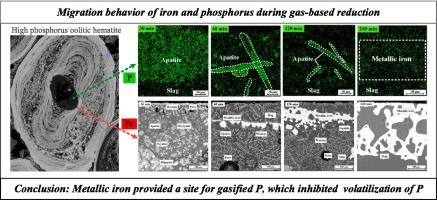当前位置:
X-MOL 学术
›
Miner. Eng.
›
论文详情
Our official English website, www.x-mol.net, welcomes your feedback! (Note: you will need to create a separate account there.)
Migration behavior of iron and phosphorus during gas-based reduction for high-phosphorus iron ore
Minerals Engineering ( IF 4.9 ) Pub Date : 2024-06-02 , DOI: 10.1016/j.mineng.2024.108765 Guangheng Ji , Cihong Xiao , Xu Gao , You Zhou , IL Sohn , Shigeru Ueda , Wanlin Wang
Minerals Engineering ( IF 4.9 ) Pub Date : 2024-06-02 , DOI: 10.1016/j.mineng.2024.108765 Guangheng Ji , Cihong Xiao , Xu Gao , You Zhou , IL Sohn , Shigeru Ueda , Wanlin Wang

|
With the depletion of high-grade iron ore, it is necessary to develop low-quality high-phosphorus iron ore through economical and sustainable solutions. In this study, we presented simultaneous enrichment of iron (Fe) and phosphorus (P) to recover P from high-phosphorus iron ore and clarified the migration of P from the original apatite to reduced iron during the direct reduction process. To capture the migration route, gas-based reduction at a relatively slow rate was conducted on two typical iron ores samples (low-grade and high-grade) at different temperatures and times. Results indicate that there are concentration gradients for P and Fe of reaction products in the low-grade iron ore at 1400 °C. The P content continuously increased in the sequence from metallic iron (Fe), wustite (FeO), and fayalite (FeSiO), to apatite (Ca(PO)F). Conversely, the content of Fe gradually decreased. During this process, P dissolved from apatite entered and formed P-bearing fayalite. For the high-grade iron ore, P-bearing fayalite with a metastable structure disappeared as the reduction progressed, and P was released and then reduced to a gaseous state, finally absorbed by metallic iron. Furthermore, when metallic iron was not formed in the initial 60 min at 1300 °C, the P migrated from the apatite to the fayalite and gas phase. As the reduction time increased from 60 min to 240 min, the formed metallic iron provided a site for gasified P, which inhibited the volatilization of P and contributed to Fe and P enrichment.
中文翻译:

高磷铁矿石气基还原过程中铁、磷的迁移行为
随着高品位铁矿石的枯竭,有必要通过经济、可持续的解决方案来开发低品质的高磷铁矿石。在这项研究中,我们提出了同时富集铁(Fe)和磷(P)以从高磷铁矿石中回收P,并阐明了P在直接还原过程中从原始磷灰石迁移到还原铁的过程。为了捕获迁移路线,在不同温度和时间下对两种典型铁矿石样品(低品位和高品位)进行了相对较慢的气体还原。结果表明,1400°C 低品位铁矿石中反应产物中的 P 和 Fe 存在浓度梯度。 P含量按金属铁(Fe)、方铁矿(FeO)、铁橄榄石(FeSiO)、磷灰石(Ca(PO)F)的顺序连续增加。相反,Fe的含量逐渐减少。在此过程中,磷灰石中溶解的P进入并形成含磷铁橄榄石。对于高品位铁矿石,亚稳态结构的含磷铁橄榄石随着还原的进行而消失,磷被释放出来,然后还原成气态,最后被金属铁吸收。此外,当在 1300°C 的最初 60 分钟内没有形成金属铁时,P 从磷灰石迁移到铁橄榄石和气相。随着还原时间从60 min增加到240 min,形成的金属铁为气化P提供了场所,抑制了P的挥发,有助于Fe和P的富集。
更新日期:2024-06-02
中文翻译:

高磷铁矿石气基还原过程中铁、磷的迁移行为
随着高品位铁矿石的枯竭,有必要通过经济、可持续的解决方案来开发低品质的高磷铁矿石。在这项研究中,我们提出了同时富集铁(Fe)和磷(P)以从高磷铁矿石中回收P,并阐明了P在直接还原过程中从原始磷灰石迁移到还原铁的过程。为了捕获迁移路线,在不同温度和时间下对两种典型铁矿石样品(低品位和高品位)进行了相对较慢的气体还原。结果表明,1400°C 低品位铁矿石中反应产物中的 P 和 Fe 存在浓度梯度。 P含量按金属铁(Fe)、方铁矿(FeO)、铁橄榄石(FeSiO)、磷灰石(Ca(PO)F)的顺序连续增加。相反,Fe的含量逐渐减少。在此过程中,磷灰石中溶解的P进入并形成含磷铁橄榄石。对于高品位铁矿石,亚稳态结构的含磷铁橄榄石随着还原的进行而消失,磷被释放出来,然后还原成气态,最后被金属铁吸收。此外,当在 1300°C 的最初 60 分钟内没有形成金属铁时,P 从磷灰石迁移到铁橄榄石和气相。随着还原时间从60 min增加到240 min,形成的金属铁为气化P提供了场所,抑制了P的挥发,有助于Fe和P的富集。






































 京公网安备 11010802027423号
京公网安备 11010802027423号